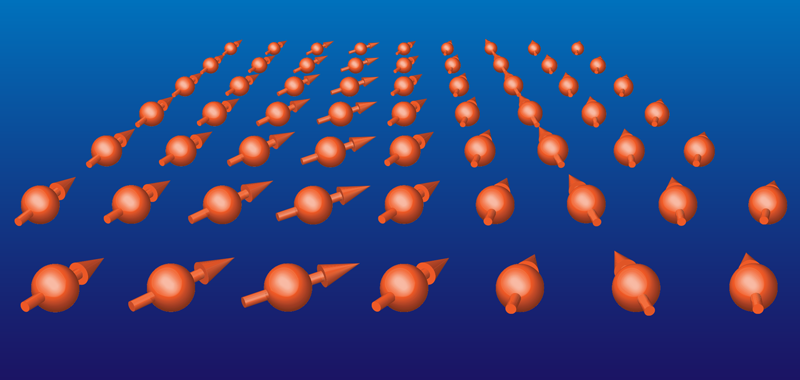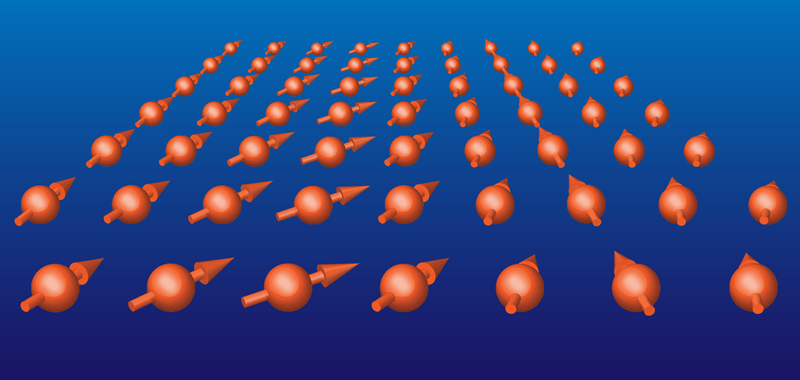• Physics 13, 51
Sound waves generate large-amplitude spin waves that travel long distances in a magnetic film and that could be used to carry information.
Spin waves—oscillations in the direction of a magnet’s internal alignment—could offer a low-power way to transport information. These oscillations can be controlled with sound waves, as demonstrated in a new experiment where sound-driven spin waves traveled 6 mm through a magnetic film, which is a longer distance than previous methods achieved. Images of the waves taken with x rays show that their amplitude—the angular change in the magnetic alignment over one wave-cycle—can be as large as 25 degrees. Such large-amplitude, long-distance waves could be well-suited for carrying information, processing data, or driving small motors.
Imagine a row of tiny magnets, or “spins,” pointing up. A spin wave pulse occurs when each spin tilts in sequence and then tips back to the vertical. In a magnetic material, the relevant spins are atomic-scale magnets that arise from the spin and motion of electrons. The use of spin waves to carry information—a concept called magnonics—has the advantage that the spins remain stationary; there is no need to push the information carriers from place to place, as with traditional electric currents.
The typical method for generating spin waves has been with small antennas that emit a time-varying magnetic field, called an Oersted field. Spins in a nearby magnet will wobble in response, but the amplitude of this wave (the maximum tilt) is typically less than a degree, and the distance traveled before dying out is only a few micrometers, due to the material’s resistance to changes in spin alignment. “It’s hard to produce large-angle waves that propagate,” says Ferran Macià from the University of Barcelona. Several alternative methods for spin-wave production exist, such as using lasers or spin-polarized currents, but the material’s resistance to wobbling spins continues to be a limitation.
Sound waves could offer another method for spin-wave generation. Researchers have long known that spin alignment (magnetization) can be changed by stretching or squeezing a magnetic material. Sound waves produce this type of strain when they pass through a solid, and researchers have observed that sound waves can induce spin wobbling in a magnet [1]. However, it has not been clear whether this wobbling forms a coherent wave pattern or not.
B. Casals et al., Phys. Rev. Lett. (2020)
To find out, Macià and his colleagues performed experiments at an x-ray facility, the ALBA Synchrotron Light Source in Spain. They placed a thin magnetic film on top of a piezoelectric, which is a material that changes shape when a voltage is applied. The researchers initially aligned the film’s spins using an external magnetic field. They then applied an oscillating voltage to the piezoelectric, generating surface acoustic waves (SAWs) in the region where the film laid over the piezoelectric.
Similar setups have been used before, but the presence of spin waves was only inferred. Macià and colleagues directly observed the spin and sound waves with x-ray imaging techniques. The images revealed SAWs on the piezoelectric with wavelengths of 8, 12, 16, or 32 micrometers, depending on the frequency of the applied voltage. The team also caused two SAWs to interfere, which produced standing-wave patterns.
Simultaneous x-ray observations showed that the film’s magnetization varied in a periodic stripe pattern that had the same wavelength as the SAW and that extended the full length of the film—about 6 mm—without signs of dying out. The magnetization variations corresponded to the spins tilting back and forth by as much as 25 degrees, which is far more than what traditional Oersted fields can do.
These sound-driven spin waves (or “magnetoacoustic waves”) could provide a compact way to send information through a microchip, Macià explains. A telecommunication signal in the gigahertz range has a wavelength of several centimeters, but that same signal could be converted with a piezoelectric-magnet system into a spin wave with a wavelength of micrometers. Such spin waves could carry information between microchip components, or they could be used in data processing units that, for example, cause two spin waves to interfere in order to perform a logic operation (see Focus: A Trio of Magnon Transistors).
“The work is excellent and provides important information about using mechanics to control magnetism dynamically at the small scale,” says magnetic material expert Greg Carman from the University of California, Los Angeles. He says that the mechanical control of magnetism is more energy efficient than other approaches using Oersted fields or spin-polarized currents. Besides possible applications in information transport and computation, he foresees using micrometer-scale magnetization inside tiny motors that could power small robots.
This research is published in Physical Review Letters.
–Michael Schirber
Michael Schirber is a Corresponding Editor for Physics based in Lyon, France.
References
- M. Weiler et al., “Elastically Driven Ferromagnetic Resonance in Nickel Thin Films,” Phys. Rev. Lett. 106, 117601 (2011).
More Information
Subject Areas
"sound" - Google News
April 03, 2020 at 10:45PM
https://ift.tt/345mGpi
Focus: Sound-Driven Spin Waves - Physics
"sound" - Google News
https://ift.tt/2MmdHZm
Shoes Man Tutorial
Pos News Update
Meme Update
Korean Entertainment News
Japan News Update






No comments:
Post a Comment